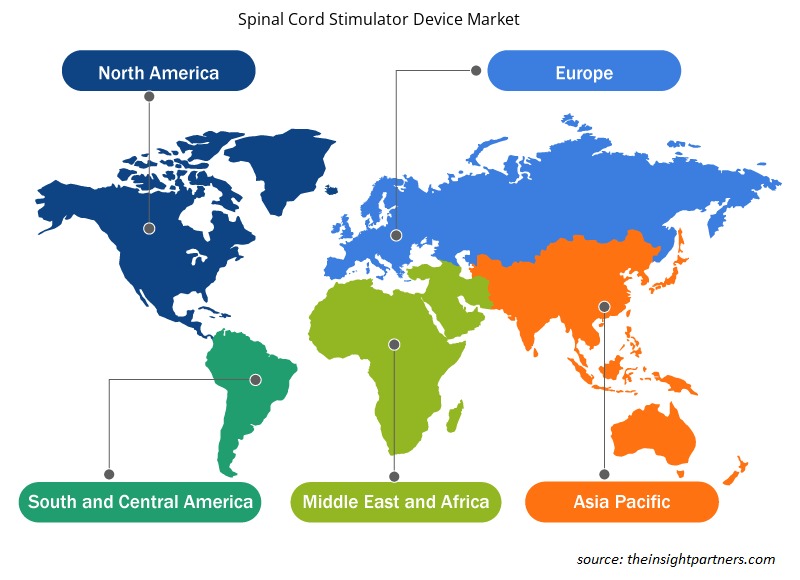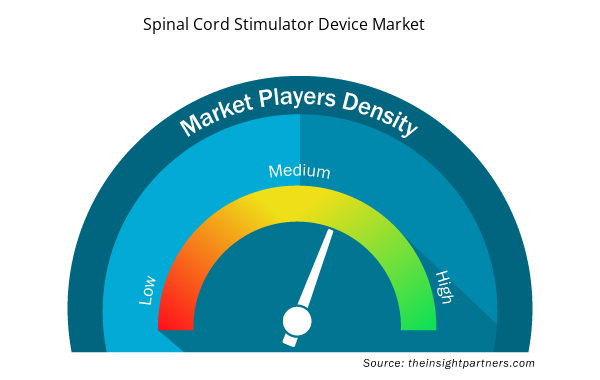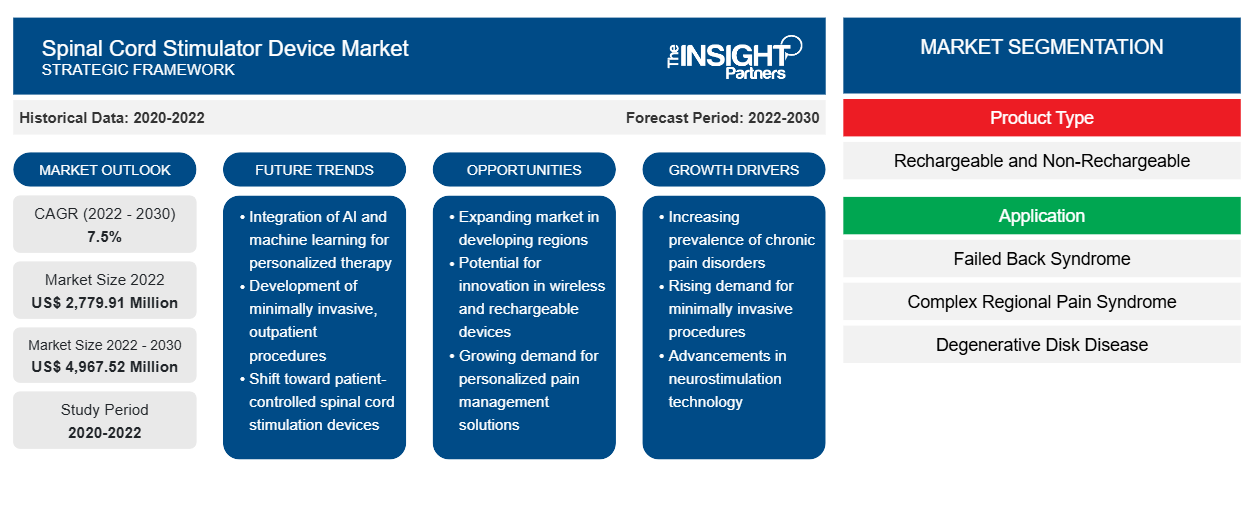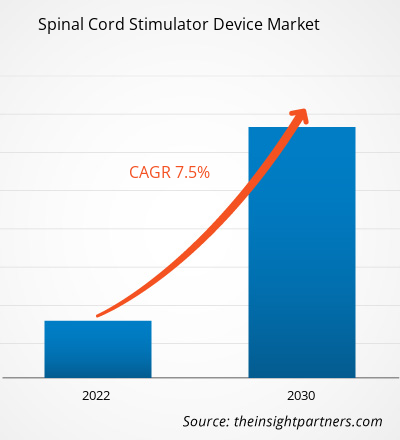[Rapporto di ricerca] Si prevede che il mercato dei dispositivi di stimolazione del midollo spinale crescerà da 2.779,91 milioni di dollari nel 2022 a 4.967,52 milioni di dollari entro il 2030; si prevede che registrerà un CAGR del 7,5% dal 2022 al 2030.
Approfondimenti di mercato e punto di vista degli analisti:
Un dispositivo di stimolazione del midollo spinale è un dispositivo impiantato che allevia il dolore trasmettendo segnali elettrici di basso livello direttamente nel midollo spinale. Lo stimolatore è utilizzato principalmente dopo che i trattamenti non chirurgici per il dolore non riescono a fornire un sollievo sufficiente. Inoltre, il dispositivo può migliorare la qualità generale della vita e del sonno. Poiché è solitamente prescritto insieme ad altri trattamenti per la gestione del dolore, sopprime efficacemente la necessità di antidolorifici. Le dimensioni del mercato dei dispositivi di stimolazione del midollo spinale si stanno espandendo con il crescente numero di lesioni del midollo spinale (SCI) e la disponibilità di trattamenti innovativi.
Fattori di crescita e sfide:
Secondo la National Library of Medicine (NLM), ogni anno nel mondo circa 250.000-500.000 pazienti soffrono di lesioni al midollo spinale (SCI). Secondo un rapporto pubblicato dall'Association for Spinal Injury Research, Rehabilitation and Reintegration (Aspire, Regno Unito), ogni anno nel Regno Unito vengono diagnosticate circa 2.500 SCI. Attualmente, circa 50.000 persone convivono con queste lesioni nel Regno Unito. Il National Spinal Cord Injury Statistical Center (NSCISC) stima che circa 320.000 persone convivano con SCI traumatiche negli Stati Uniti. Un numero elevato di casi è attribuito alle competizioni di motocross e motociclismo che stanno emergendo come le attività sportive più popolari al mondo, secondo il rapporto del National Institute of Health (NIH).
Inoltre, queste lesioni sono comuni nella popolazione anziana. Secondo i dati presentati nella raccolta di indicatori di sviluppo della Banca Mondiale nel 2022, il 22,41% della popolazione in Germania ha più di 65 anni. Un articolo pubblicato da MDPI menziona che il tasso di prevalenza di SCI traumatiche è di circa 500 per milione di abitanti e il tasso di incidenza sale a 13 per milione a livello globale.
Le SCI hanno un impatto che cambia la vita dei pazienti feriti e delle loro famiglie. L'incidenza crescente di SCI e il corrispondente trattamento dei pazienti in ospedale è seguito da almeno un ricovero del paziente ogni anno. Questo perché le SCI non vengono curate immediatamente. Le cause di ricovero ospedaliero includono infezioni respiratorie e del tratto urinario e fratture che si verificano durante le attività sportive motociclistiche. Con l'aumento delle SCI e la disponibilità di infrastrutture ben sviluppate nei centri di trattamento che forniscono programmi di riabilitazione, la domanda di dispositivi di stimolazione del midollo spinale sta aumentando nei centri specializzati o di riabilitazione, alimentando la crescita del dispositivo di stimolazione del midollo spinale.
Personalizza questo report in base alle tue esigenze
Riceverai la personalizzazione gratuita di qualsiasi report, comprese parti di questo report, o analisi a livello nazionale, pacchetto dati Excel, oltre a usufruire di grandi offerte e sconti per start-up e università
- Scopri le principali tendenze di mercato in questo rapporto.Questo campione GRATUITO includerà analisi di dati che spaziano dalle tendenze di mercato alle stime e alle previsioni.
Segmentazione e ambito del report:
Il mercato dei dispositivi di stimolazione del midollo spinale è suddiviso in base al tipo di prodotto, all'applicazione, all'utente finale e alla geografia. In base al tipo di prodotto, il mercato dei dispositivi di stimolazione del midollo spinale è suddiviso in ricaricabile e non ricaricabile. Il mercato dei dispositivi di stimolazione del midollo spinale è segmentato in base all'applicazione in sindrome della schiena fallita, sindrome del dolore regionale complesso, malattia degenerativa del disco e altri. In termini di utente finale, il mercato è suddiviso in ospedali, centri di chirurgia ambulatoriale e altri. In base alla geografia, il mercato dei dispositivi di stimolazione del midollo spinale è segmentato in Nord America (Stati Uniti, Canada e Messico), Europa (Regno Unito, Germania, Francia, Italia, Spagna, Russia e resto d'Europa), Asia Pacifico (Cina, Giappone, India, Corea del Sud, Australia, Sud-est asiatico e resto dell'Asia Pacifico), Medio Oriente e Africa (Emirati Arabi Uniti, Arabia Saudita, Sud Africa e resto del Medio Oriente e Africa) e Sud e Centro America (Brasile, Argentina e resto del Sud e Centro America).
Analisi segmentale:
Il mercato dei dispositivi di stimolazione del midollo spinale è segmentato in base all'applicazione in sindrome della schiena fallita, sindrome del dolore regionale complesso, malattia degenerativa del disco e altri. Il segmento della sindrome del dolore regionale complesso ha detenuto la quota di mercato più grande nel 2022. Si prevede che registrerà il CAGR più elevato nel periodo 2022-2030. La sindrome del dolore regionale complesso (CRPS) comporta dolore e infiammazione prolungati che si verificano a causa di una lesione o di altri eventi medici come interventi chirurgici, traumi, ictus e infarto. La CRPS può verificarsi in qualsiasi parte del corpo, solitamente colpendo il braccio, la gamba, la mano o il piede. È più probabile che si verifichi in chiunque a qualsiasi età, con l'infiammazione che si avvicina al picco dopo i 40 anni. La maggior parte dei casi di CRPS è causata da piccole fibre nervose periferiche C danneggiate o mal funzionanti, che trasportano segnali di dolore al cervello. La CRPS spesso rimane non diagnosticata con lo sviluppo di piccoli coaguli, a volte bloccando il flusso sanguigno ai nervi e danneggiandoli.
Mercato dei dispositivi di stimolazione del midollo spinale, per applicazione – 2022 e 2030
Analisi regionale:
In base alla geografia, il mercato dei dispositivi di stimolazione del midollo spinale è suddiviso in Nord America, Europa, Asia Pacifico, Medio Oriente e Africa e Sud e Centro America. Il Nord America è il maggiore contributore alla crescita del mercato globale dei dispositivi di stimolazione del midollo spinale. Si prevede che l'Asia Pacifico registrerà il CAGR più elevato nel mercato dei dispositivi di stimolazione del midollo spinale dal 2022 al 2030. L'incidenza in continuo aumento delle lesioni del midollo spinale è associata alla crescita di questo mercato. Attualmente, le lesioni del midollo spinale rappresentano un grave onere per la salute nei paesi nordamericani. Secondo Spinal Cord Inc., circa 18.000 persone negli Stati Uniti soffrono di queste lesioni ogni anno.
Approfondimenti regionali sul mercato dei dispositivi di stimolazione del midollo spinale
Le tendenze regionali e i fattori che influenzano il mercato dei dispositivi di stimolazione del midollo spinale durante il periodo di previsione sono stati ampiamente spiegati dagli analisti di Insight Partners. Questa sezione discute anche i segmenti e la geografia del mercato dei dispositivi di stimolazione del midollo spinale in Nord America, Europa, Asia Pacifico, Medio Oriente e Africa e America meridionale e centrale.

- Ottieni i dati specifici regionali per il mercato dei dispositivi di stimolazione del midollo spinale
Ambito del rapporto di mercato sui dispositivi di stimolazione del midollo spinale
| Attributo del report | Dettagli |
|---|---|
| Dimensioni del mercato nel 2022 | 2.779,91 milioni di dollari USA |
| Dimensioni del mercato entro il 2030 | 4.967,52 milioni di dollari USA |
| CAGR globale (2022-2030) | 7,5% |
| Dati storici | 2020-2022 |
| Periodo di previsione | 2022-2030 |
| Segmenti coperti | Per tipo di prodotto
|
| Regioni e Paesi coperti | America del Nord
|
| Leader di mercato e profili aziendali chiave |
|
Densità degli attori del mercato: comprendere il suo impatto sulle dinamiche aziendali
Il mercato dei dispositivi di stimolazione del midollo spinale sta crescendo rapidamente, spinto dalla crescente domanda degli utenti finali dovuta a fattori quali l'evoluzione delle preferenze dei consumatori, i progressi tecnologici e una maggiore consapevolezza dei benefici del prodotto. Con l'aumento della domanda, le aziende stanno ampliando le loro offerte, innovando per soddisfare le esigenze dei consumatori e capitalizzando sulle tendenze emergenti, il che alimenta ulteriormente la crescita del mercato.
La densità degli operatori di mercato si riferisce alla distribuzione di aziende o società che operano in un particolare mercato o settore. Indica quanti concorrenti (operatori di mercato) sono presenti in un dato spazio di mercato in relazione alle sue dimensioni o al valore di mercato totale.
Le principali aziende che operano nel mercato dei dispositivi di stimolazione del midollo spinale sono:
- Boston Scientific Corp
- Società Nevro
- Laboratori Abbott
- Cirtec Medical Corp
- Medtronica SpA
Disclaimer : le aziende elencate sopra non sono classificate secondo un ordine particolare.

- Ottieni la panoramica dei principali attori del mercato dei dispositivi di stimolazione del midollo spinale
Sviluppi del settore e opportunità future:
Di seguito sono elencate le principali iniziative dei principali attori che operano nel mercato dei dispositivi di stimolazione del midollo spinale:
- Ad agosto 2022, Abbott Laboratories ha ricevuto l'approvazione dalla FDA statunitense per il suo sistema Proclaim Plus SCS per il trattamento del dolore cronico. La tecnologia di stimolazione BurstDR consente al dispositivo di fornire un sollievo dal dolore superiore. Offre la terapia FlexBurst360 che offre copertura del dolore su tronco e arti; il dispositivo può essere programmato in base alle mutevoli esigenze terapeutiche del paziente.
- A dicembre 2022, il sistema di stimolazione del midollo spinale (SCS) Eterna di Abbott Laboratories sarà disponibile per il trattamento del dolore cronico. La stimolazione BurstDR a basso dosaggio di Abbott, una tecnologia brevettata di forma d'onda SCS a basso dosaggio con la più grande evidenza clinica, è stata approvata dalla FDA. Inoltre, è stato dimostrato che la tecnica aiuta a ridurre il dolore del 23% in più rispetto ai risultati prodotti dai metodi convenzionali basati sulla tecnologia della forma d'onda.
Scenario competitivo e aziende chiave:
Alcuni dei principali attori che operano nel mercato dei dispositivi di stimolazione del midollo spinale sono Boston Scientific Corp; Nevro Corp; Abbott Laboratories; Cirtec Medical Corp; Medtronic Plc; Biotronik SE & Co KG; Curonix LLC; Nalu Medical, Inc.; e Synapse Biomedical Inc. Queste aziende si concentrano sul lancio di nuovi prodotti e sulle espansioni geografiche per soddisfare la domanda globale dei consumatori e aumentare la loro gamma di prodotti nei portafogli specializzati. La loro presenza globale consente loro di servire un'ampia base di clienti, facilitando successivamente l'espansione del mercato.
- Analisi storica (2 anni), anno base, previsione (7 anni) con CAGR
- Analisi PEST e SWOT
- Valore/volume delle dimensioni del mercato - Globale, regionale, nazionale
- Industria e panorama competitivo
- Set di dati Excel



Report Coverage
Revenue forecast, Company Analysis, Industry landscape, Growth factors, and Trends

Segment Covered
This text is related
to segments covered.

Regional Scope
North America, Europe, Asia Pacific, Middle East & Africa, South & Central America

Country Scope
This text is related
to country scope.
Domande frequenti
Based on product type, the spinal cord stimulator device market is bifurcated into rechargeable and non-rechargeable. The rechargeable segment held a larger market share in 2022 and is expected to record a significant CAGR during 2022–2030. In terms of end users, the spinal cord stimulator device market is categorized into hospitals, ambulatory surgery centers, and others. The hospital segment held the largest share of the market in 2022 and is anticipated to register the highest CAGR during 2022–2030.
Based on geography, the spinal cord stimulator device market is segmented into North America (the US, Canada, and Mexico), Europe (the UK, Germany, France, Italy, Spain, and the Rest of Europe), Asia Pacific (China, Japan, India, South Korea, Australia, and the Rest of Asia Pacific), the Middle East & Africa (the UAE, Saudi Arabia, South Africa, and Rest of the Middle East & Africa), and South & Central America (Brazil, Argentina, and the Rest of South & Central America). North America is the largest contributor to the growth of the global spinal cord stimulator device market. Asia Pacific is expected to register the highest CAGR in the spinal cord stimulator device market from 2022 to 2030.
The spinal cord stimulator device market majorly consists of players such as Boston Scientific Corp, Nevro Corp, Abbott Laboratories, Cirtec Medical Corp, Medtronic Plc, Biotronik SE & Co KG, Curonix LLC, Nalu Medical Inc, and Synapse Biomedical Inc
The increasing cases of spinal cord injuries and strategic initiatives by companies bolster the spinal cord stimulator devices market size. However, the high cost associated with spinal cord stimulator devices hinders the market growth.
A spinal cord stimulation device is an implanted device that relieves pain by transmitting low-level electrical signals directly into the spinal cord. The stimulator is mostly used after nonsurgical pain treatments fail to provide sufficient relief. Additionally, the device can improve the overall quality of life and sleep. As it is typically prescribed along with other pain management treatments, it effectively suppresses the need for pain medicines. The spinal cord stimulator device market size is expanding with the rising number of spinal cord injuries (SCIs) and the availability of innovative treatments.
Trends and growth analysis reports related to Life Sciences : READ MORE..
The List of Companies - Spinal Cord Stimulator Device Market
- Boston Scientific Corp
- Nevro Corp
- Abbott Laboratories
- Cirtec Medical Corp
- Medtronic Plc
- Biotronik SE & Co KG
- Curonix LLC
- Nalu Medical, Inc.
- Synapse Biomedical Inc
The Insight Partners performs research in 4 major stages: Data Collection & Secondary Research, Primary Research, Data Analysis and Data Triangulation & Final Review.
- Data Collection and Secondary Research:
As a market research and consulting firm operating from a decade, we have published and advised several client across the globe. First step for any study will start with an assessment of currently available data and insights from existing reports. Further, historical and current market information is collected from Investor Presentations, Annual Reports, SEC Filings, etc., and other information related to company’s performance and market positioning are gathered from Paid Databases (Factiva, Hoovers, and Reuters) and various other publications available in public domain.
Several associations trade associates, technical forums, institutes, societies and organization are accessed to gain technical as well as market related insights through their publications such as research papers, blogs and press releases related to the studies are referred to get cues about the market. Further, white papers, journals, magazines, and other news articles published in last 3 years are scrutinized and analyzed to understand the current market trends.
- Primary Research:
The primarily interview analysis comprise of data obtained from industry participants interview and answers to survey questions gathered by in-house primary team.
For primary research, interviews are conducted with industry experts/CEOs/Marketing Managers/VPs/Subject Matter Experts from both demand and supply side to get a 360-degree view of the market. The primary team conducts several interviews based on the complexity of the markets to understand the various market trends and dynamics which makes research more credible and precise.
A typical research interview fulfils the following functions:
- Provides first-hand information on the market size, market trends, growth trends, competitive landscape, and outlook
- Validates and strengthens in-house secondary research findings
- Develops the analysis team’s expertise and market understanding
Primary research involves email interactions and telephone interviews for each market, category, segment, and sub-segment across geographies. The participants who typically take part in such a process include, but are not limited to:
- Industry participants: VPs, business development managers, market intelligence managers and national sales managers
- Outside experts: Valuation experts, research analysts and key opinion leaders specializing in the electronics and semiconductor industry.
Below is the breakup of our primary respondents by company, designation, and region:

Once we receive the confirmation from primary research sources or primary respondents, we finalize the base year market estimation and forecast the data as per the macroeconomic and microeconomic factors assessed during data collection.
- Data Analysis:
Once data is validated through both secondary as well as primary respondents, we finalize the market estimations by hypothesis formulation and factor analysis at regional and country level.
- Macro-Economic Factor Analysis:
We analyse macroeconomic indicators such the gross domestic product (GDP), increase in the demand for goods and services across industries, technological advancement, regional economic growth, governmental policies, the influence of COVID-19, PEST analysis, and other aspects. This analysis aids in setting benchmarks for various nations/regions and approximating market splits. Additionally, the general trend of the aforementioned components aid in determining the market's development possibilities.
- Country Level Data:
Various factors that are especially aligned to the country are taken into account to determine the market size for a certain area and country, including the presence of vendors, such as headquarters and offices, the country's GDP, demand patterns, and industry growth. To comprehend the market dynamics for the nation, a number of growth variables, inhibitors, application areas, and current market trends are researched. The aforementioned elements aid in determining the country's overall market's growth potential.
- Company Profile:
The “Table of Contents” is formulated by listing and analyzing more than 25 - 30 companies operating in the market ecosystem across geographies. However, we profile only 10 companies as a standard practice in our syndicate reports. These 10 companies comprise leading, emerging, and regional players. Nonetheless, our analysis is not restricted to the 10 listed companies, we also analyze other companies present in the market to develop a holistic view and understand the prevailing trends. The “Company Profiles” section in the report covers key facts, business description, products & services, financial information, SWOT analysis, and key developments. The financial information presented is extracted from the annual reports and official documents of the publicly listed companies. Upon collecting the information for the sections of respective companies, we verify them via various primary sources and then compile the data in respective company profiles. The company level information helps us in deriving the base number as well as in forecasting the market size.
- Developing Base Number:
Aggregation of sales statistics (2020-2022) and macro-economic factor, and other secondary and primary research insights are utilized to arrive at base number and related market shares for 2022. The data gaps are identified in this step and relevant market data is analyzed, collected from paid primary interviews or databases. On finalizing the base year market size, forecasts are developed on the basis of macro-economic, industry and market growth factors and company level analysis.
- Data Triangulation and Final Review:
The market findings and base year market size calculations are validated from supply as well as demand side. Demand side validations are based on macro-economic factor analysis and benchmarks for respective regions and countries. In case of supply side validations, revenues of major companies are estimated (in case not available) based on industry benchmark, approximate number of employees, product portfolio, and primary interviews revenues are gathered. Further revenue from target product/service segment is assessed to avoid overshooting of market statistics. In case of heavy deviations between supply and demand side values, all thes steps are repeated to achieve synchronization.
We follow an iterative model, wherein we share our research findings with Subject Matter Experts (SME’s) and Key Opinion Leaders (KOLs) until consensus view of the market is not formulated – this model negates any drastic deviation in the opinions of experts. Only validated and universally acceptable research findings are quoted in our reports.
We have important check points that we use to validate our research findings – which we call – data triangulation, where we validate the information, we generate from secondary sources with primary interviews and then we re-validate with our internal data bases and Subject matter experts. This comprehensive model enables us to deliver high quality, reliable data in shortest possible time.


 Ottieni un campione gratuito per questo repot
Ottieni un campione gratuito per questo repot